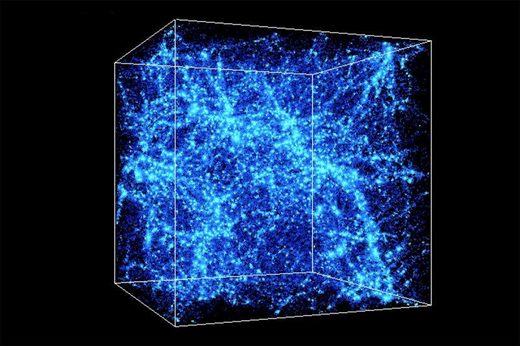Scientists have finally found half of the universe's missing matter
Leah Crane
New Scientist
Mon, 09 Oct 2017 21:43 UTC
Discoveries seem to back up many of our ideas about how the universe got its large-scale structure.
The missing links between galaxies have finally been found. This is the first detection of the roughly half of the normal matter in our universe - protons, neutrons and electrons - unaccounted for by previous observations of stars, galaxies and other bright objects in space.
You have probably heard about the hunt for dark matter, a mysterious substance thought to permeate the universe, the effects of which we can see through its gravitational pull. But our models of the universe also say there should be about twice as much ordinary matter out there, compared with what we have observed so far.
Two separate teams found the missing matter - made of particles called baryons rather than dark matter - linking galaxies together through filaments of hot, diffuse gas.
"The missing baryon problem is solved," says Hideki Tanimura at the Institute of Space Astrophysics in Orsay, France, leader of one of the groups. The other team was led by Anna de Graaff at the University of Edinburgh, UK.
Because the gas is so tenuous and not quite hot enough for X-ray telescopes to pick up, nobody had been able to see it before.
"There's no sweet spot - no sweet instrument that we've invented yet that can directly observe this gas," says Richard Ellis at University College London. "It's been purely speculation until now."
So the two groups had to find another way to definitively show that these threads of gas are really there.
Both teams took advantage of a phenomenon called the Sunyaev-Zel'dovich effect that occurs when light left over from the big bang passes through hot gas. As the light travels, some of it scatters off the electrons in the gas, leaving a dim patch in the cosmic microwave background - our snapshot of the remnants from the birth of the cosmos.
Stack 'em up
In 2015, the Planck satellite created a map of this effect throughout the observable universe. Because the tendrils of gas between galaxies are so diffuse, the dim blotches they cause are far too slight to be seen directly on Planck's map.
Both teams selected pairs of galaxies from the Sloan Digital Sky Survey that were expected to be connected by a strand of baryons. They stacked the Planck signals for the areas between the galaxies, making the individually faint strands detectable en masse.
Tanimura's team stacked data on 260,000 pairs of galaxies, and de Graaff's group used over a million pairs. Both teams found definitive evidence of gas filaments between the galaxies. Tanimura's group found they were almost three times denser than the mean for normal matter in the universe, and de Graaf's group found they were six times denser - confirmation that the gas in these areas is dense enough to form filaments.
"We expect some differences because we are looking at filaments at different distances," says Tanimura. "If this factor is included, our findings are very consistent with the other group."
Finally finding the extra baryons that have been predicted by decades of simulations validates some of our assumptions about the universe.
"Everybody sort of knows that it has to be there, but this is the first time that somebody - two different groups, no less - has come up with a definitive detection," says Ralph Kraft at the Harvard-Smithsonian Center for Astrophysics in Massachusetts.
"This goes a long way toward showing that many of our ideas of how galaxies form and how structures form over the history of the universe are pretty much correct," he says.
Related:
Fermilab Scientists Discover New Particle
- Home
- Forum
- Chat
- Donate
- What's New?
-
Site Links

-
Avalon Library

-
External Sites

- Solari Report | Catherine Austin Fitts
- The Wall Will Fall | Vanessa Beeley
- Unsafe Space | Keri Smith
- Giza Death Star | Joseph P. Farrell
- The Last American Vagabond
- Caitlin Johnstone
- John Pilger
- Voltaire Network
- Suspicious Observers
- Peak Prosperity | Chris Martenson
- Dark Journalist
- The Black Vault
- Global Research | Michael Chossudovsky
- Corbett Report
- Infowars
- Natural News
- Ice Age Farmer
- Dr. Joseph Mercola
- Childrens Health Defense
- Geoengineering Watch | Dane Wigington
- Truthstream Media
- Unlimited Hangout | Whitney Webb
- Wikileaks index
- Vaccine Impact
- Eva Bartlett (In Gaza blog)
- Scott Ritter
- Redacted (Natalie & Clayton Morris)
- Judging Freedom (Andrew Napolitano)
- Alexander Mercouris
- The Duran
- Simplicius The Thinker






 Reply With Quote
Reply With Quote

Bookmarks